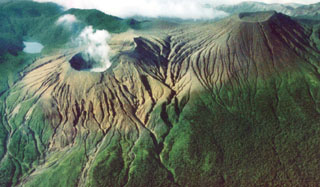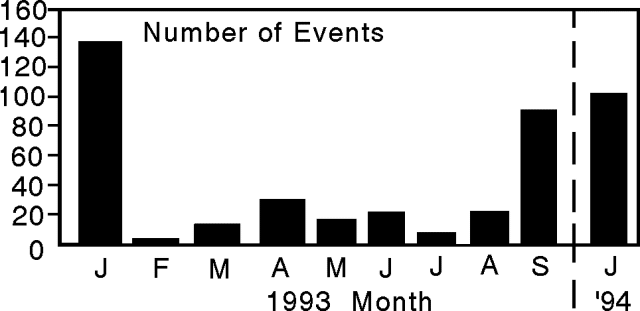Report on Rincon de la Vieja (Costa Rica) — January 1994
Bulletin of the Global Volcanism Network, vol. 19, no. 1 (January 1994)
Managing Editor: Richard Wunderman.
Rincon de la Vieja (Costa Rica) New seismic data, but still relatively quiet
Please cite this report as:
Global Volcanism Program, 1994. Report on Rincon de la Vieja (Costa Rica) (Wunderman, R., ed.). Bulletin of the Global Volcanism Network, 19:1. Smithsonian Institution. https://doi.org/10.5479/si.GVP.BGVN199401-345020
Rincon de la Vieja
Costa Rica
10.8314°N, 85.3364°W; summit elev. 1729 m
All times are local (unless otherwise noted)
During 1993 Rincón de la Vieja continued fumarolic venting in Rincón crater. Gas columns rose to 500 m high and contained sufficient gas concentrations to irritate the eyes and sting the skin of observers on the crater margin. The crater lake was clear gray in color, with clouds of suspended sulfur and several areas of discontinuous bubbling. It had a temperature of 35°C.
When seismically active, as in January and September 1993 (figure 8), both high- and low-frequency signals were common. A swarm of 25 high-frequency events took place on 26-29 January. On 26 March, 10 small-amplitude high-frequency events registered, their S - P (S minus P) times were
Geological Summary. Rincón de la Vieja is a volcanic complex in the Guanacaste Range of NW Costa Rica. Sometimes referred to as the Rincon de la Vieja-Santa María Volcanic Complex, it consists of a slightly arcuate 20-km-long ridge of 12 craters and pyroclastic cones constructed within the 15-km-wide early Pleistocene Guachipelín caldera, whose rim is exposed on the south side. Sometimes known as the "Colossus of Guanacaste," it has an estimated volume of 130 km3 and contains at least nine major eruptive centers. The Santa María cone, the highest peak of the complex, is located on the E side of the ridge and has a lake within the 400-m-diameter crater. A Plinian eruption producing the 0.25 km3 Río Blanca tephra about 3,500 years ago was the last major magmatic eruption. All subsequent eruptions, including numerous reported eruptions possibly dating back to the 16th century, have been from the active crater, near the center of the complex, with an acidic 300-m-diameter lake.
Information Contacts: E. Fernández, J. Barquero, R. Van der Laat, F. de Obaldia, T. Marino, V. Barboza, and R. Sáenz, OVSICORI.


